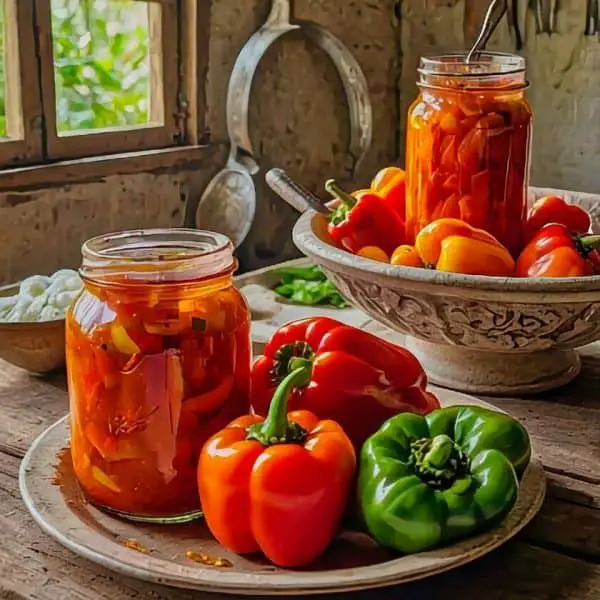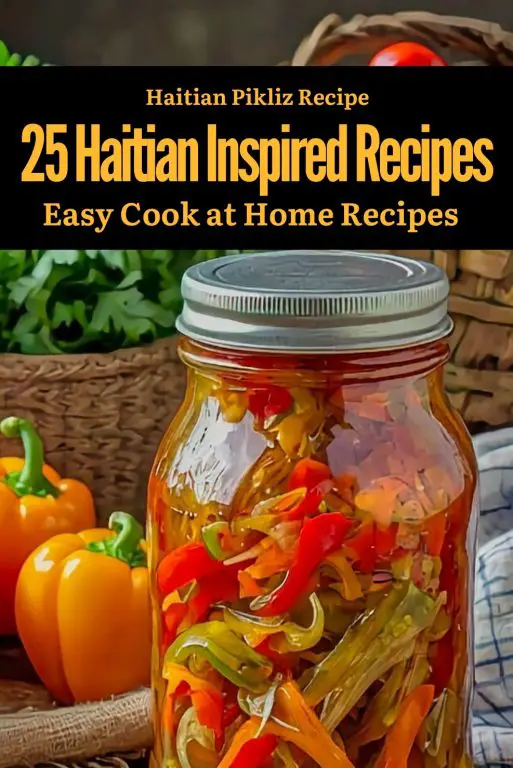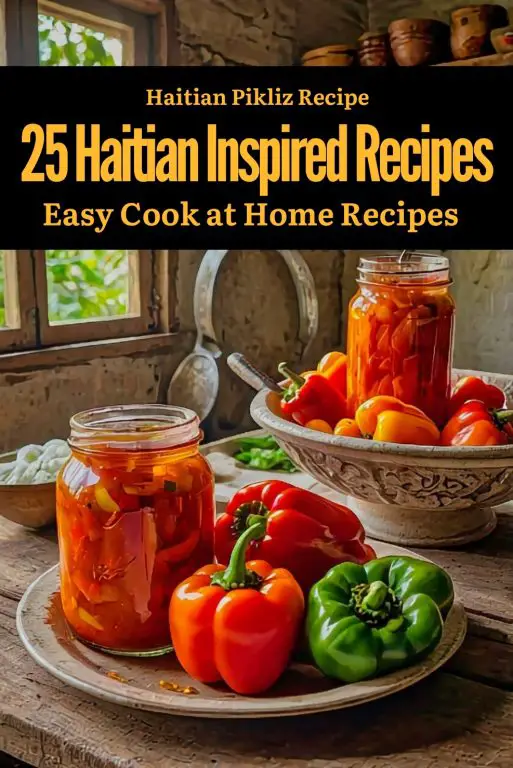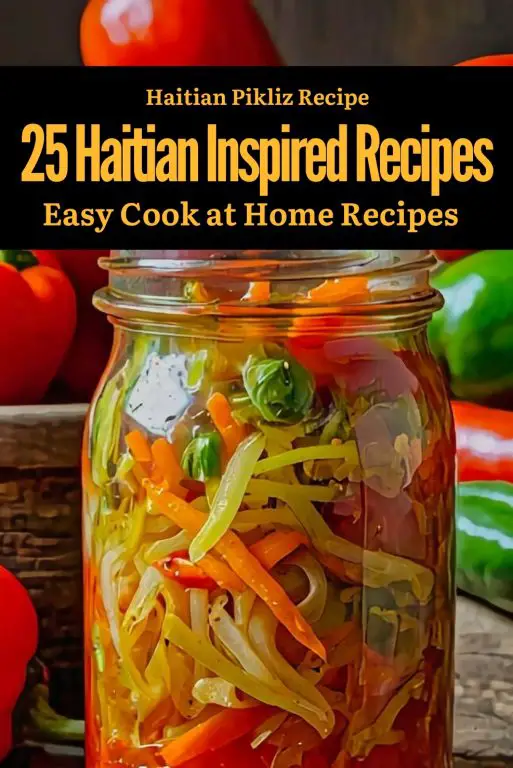I found the Haitian Pikliz Recipe While in Haiti. I stayed at a small hostel where I compiled recipes for my food blog. While focusing on Haitian dishes, I met a fellow traveler who shared her favorite recipe and we madethe Haitian Pikliz.
Pikliz is a hot and tangy condiment that goes with many Haitian meals. It’s basically a pickled vegetable dish that features fresh vegetables and Scotch Bonnet peppers.
Shredded cabbage makes the Haitian Pikliz Recipe. Then you blend it with shredded carrots, scallions, onions and bell peppers. The produce makes a colorful and crunchy base for the hot marinade. We threw in little Scotch Bonnet pepper pieces to make it spicy and we pickedled everything with white vinegar and fresh lime juice [it tasted tangy]. Dried thyme and black peppercorns finished the seasoning with mild earthy flavors.
When we were preparing the Haitian Pikliz Recipe we talked about how healthy the ingredients are. The main component is cabbage and It is rich in fibre, vitamins K and C and has antioxidants good for digestion and the immune system. Carrots have beta carotene, which aids in improving eyesight and the function of body tissues.
Bell peppers are high in vitamins C and a, making the Haitian Pikliz Recipe A healthy meal option. Using fresh vegetables and not cooking too much preserves their nutrients making Pikliz a healthy side dish for heavier meals.
There are ways to make the Haitian Pikliz Recipe healthier. For example, less salt in the recipe or kosher salt carefully can reduce the sodium intake without sacrificing taste. You may even use apple cider vinegar rather than white vinegar since it’s healthy. It helps with digestion and keeping blood sugar stable.
Another change could be less Scotch Bonnet peppers, making it less spicy for those sensitive to hot foods but still makes Pikliz tangy for those who like spicy food.
When I got this Recipe I realized how flexible the Haitian Pikliz recipe is. It is a colorful side dish that can make rich and heavy meals better with its spicy taste. This recipe utilizes fresh veggies and just the proper amounts of vinegar, salt, along with spices. It tastes great and packs a good dose of nutrients, so it’s an ideal snack for people who desire more vegetables.
Ingredients For the Haitian Pikliz Recipe
Finely Shredded Small head of cabbage
Julienned or Grated large carrot
Thinly Sliced Medium Bell Pepper (any color)
Thinly Sliced Small Onion, thinly sliced
Chopped Scallions, chopped
Finely Chopped Scotch Bonnet Peppers
Kosher Salt
Black Peppercorns
Minced Cloves Garlic
Dried Thyme
White Vinegar
Freshly Squeezed Lime Juice
Cooking Instructions For the Haitian Pikliz Recipe
- In a large mixing bowl, combine the shredded cabbage, carrot, bell pepper, onion, and scallions. Mix well. Add the chopped Scotch bonnet peppers, salt, black peppercorns, minced garlic, and dried thyme to the vegetable mixture, stirring well to combine.
- In a separate bowl or measuring cup, combine the white vinegar and lime juice. Pour the vinegar and lime juice mixture over the vegetables, ensuring that all the ingredients are submerged. If needed, add more vinegar to cover the vegetables completely.
- Transfer the mixture to a clean, airtight glass jar or container. Seal the container and refrigerate for at least 24 hours to allow the flavors to meld and the vegetables to pickle. For best results, allow the Pikliz to marinate for 2-3 days before serving.
- Serve your Haitian Pikliz as a side dish or condiment with your favorite meals. The Pikliz can be stored in the refrigerator for up to 3 weeks.
Foods Most Eaten by Haitian Locals
Haitian cuisine reflects African, French, Taino, and Spanish culinary traditions. Another staple food in Haitian households is “diri ak pwa,” or rice and beans, consisting of black, red or white beans with spices and typically meat or fish. Griot (marinated and fried pork) is a popular dish served with “banan peze,” fried plantains, and pikliz (spicy pickled vegetable slaw). This is a popular combination at gatherings and celebrations.
Another popular dish is legim, a stew of vegetables that combines spinach with chayote, eggplant along with other vegetables and is usually cooked with meat or seafood and served with rice. A comforting meal on weekends is “bouillon,” a thick soup with beef, plantains, yams and other vegetables. For breakfast, “akasan,” a warm cornmeal porridge with milk and cinnamon, is a popular breakfast option.
Street food is also a staple in Haitian cuisine, with vendors selling various snacks. Pate is a flaky pastry filled with meat, fish or vegetables that is usually eaten on the go, and fritay is a platter of fried foods that include plantains, malanga, and sometimes seafood. Soup joumou, a pumpkin soup eaten on New Year’s Day to celebrate Haitian independence, is symbolic and popular. Together these dishes reflect the diversity and richness of Haitian food culture that reflects its people’s resilience and creativity.
10 Reasons I Love Haitian Food
1. Rich Flavors and Diverse Flavors: Haitian food is usually complicated and bold, using an assortment of herbs and spices. Incorporating savory and aromatic tastes, each meal is a sensory treat. Using ingredients like garlic, thyme, Scotch bonnet peppers and cloves gives this a taste that you simply will not find anywhere.
2. Cultural Heritage: Haitian cuisine reflects the nation’s cultural past and also consists of African, French, Taino and Spanish influences. This diverse heritage is reflected in the dishes and techniques of cooking, making each meal a culinary journey through history. Haitian food is like tasting a piece of the nation’s culture and traditions.
3. Comfort Food at Its Best: Lots of Haitian dishes are hearty and filling, including soup joumou and bouillon. These meals are usually shared together with friends and family. The comforting food and sharing is what makes it a real heartwarming experience.
4. Use of Fresh Ingredients: Haitian cuisine utilizes fresh, local ingredients which add flavor and provide a healthy meal. From fresh veggies and herbs to meats and seafood, quality ingredients are part of the main reason Haitian food tastes good and is good for you.
5. Versatility of Plantains: The most used component in Haitian food preparation is the plantain. It might be fried, boiled, baked or mashed. Foods like banan peze (fried plantains) and labouyi banan (plantain porridge) showcase the versatile staple.
6. Unique Spice Blends: A crucial component in many Haitian food items is the distinctive spice combination referred to as epis. Made of garlic, bell peppers, onions, parsley, thyme along with other ingredients it’s used as the base for marinades, soups and stews. The flavorful and aromatic profile of epis makes every dish it touches uniquely Haitian.
7. Dishes with Diverse Seafood: As an island nation, Haiti has lots of fresh seafood. Dishes such as poisson gros sel (salted fish) and lalo (jute leaves cooked with crab or shrimp) demonstrate the range of seafood and also the methods they’re prepared. These dishes are flavorful and showcase the sea.
8. Emphasis on Community and Sharing: Haitian meals are frequently shared by loved ones and friends who share food and stories. This emphasis on togetherness makes dining more meaningful and enjoyable, bringing people together over food.
9. Bold and Spicy Flavors: Haitian food tends to be spicy and hot. Scotch bonnet peppers and pikliz (spicy pickled veggies) add a fiery kick to many meals. This particular spiciness coupled with other flavors is a hallmark of the cuisine.
10. Celebration of Traditions: A few Haitian dishes are traditional and are prepared for special occasions and celebrations. As an example, soup joumou is served on New Year’s Day to celebrate Haitian independence. Preparation and sharing of these traditional foods are a way of preserving Haitian culture.
5 Essiential Ingredients for Haitian Food
Epis (Haitian Seasoning Base): Epis may be the main ingredient of Haitian food preparation – a vibrant blend of herbs, spices and vegetables that marinate meats and flavor stews, sauces and rice dishes. Made with garlic, scallions, bell peppers, onions, parsley, thyme and quite often Scotch bonnet peppers, epis is crucial to Haitian food. It is often made in large batches and stored for use in everyday cooking.
Scotch Bonnet Peppers: Scotch bonnet peppers are an essential ingredient in Haitian food preparation, because of their heat and fruity flavor. They are used in pikliz (a spicy pickled vegetable relish), marinades and soups. The pepper is a component of the bold flavors of Haitian food.
Plantains: A staple in Haitian cuisine, plantains are fried, boiled or mashed in various dishes. They are usually a side dish or snack. A popular dish is “Banan peze,” or twice-fried plantains, and “bouyon” may consist of plantains in a broth with meat and vegetables. Plantains provide a starchy, slightly sweet accompaniment to meals, and help temper the heat in many dishes.
Rice: Rice is a staple item in Haitian diets, often served with beans, vegetables or meats. Favorite dishes include “diri ak djon djon” (black mushroom rice) or “diri ak pwa” (rice with beans). Many traditional dishes are served on rice that absorbs the flavors of sauces and stews.
Thyme: Thyme is a common herb used in Haitian cooking, giving dishes an extremely earthy and aromatic note. It is used in epis, soups, stews, and meat marinades. Its subtle yet strong taste goes well with the strong flavors and spices of Haitian food and is an essential item in the Haitian pantry.
FAQ For the Haitian Pikliz Recipe
Q: 1. What vegetables are traditionally used in the Haitian Pikliz recipe?
A: The Haitian Pikliz recipe traditionally uses a mix of cabbage, carrots, and bell peppers, all thinly sliced to create a crisp texture. Scotch bonnet peppers are an essential ingredient, providing the signature heat. Onions, green onions, and garlic are also added for extra flavor. The vegetables are soaked in a vinegar-based brine, which not only preserves them but also enhances their flavors. The combination of crunchy vegetables and spicy peppers makes the Haitian Pikliz recipe a refreshing and fiery condiment that pairs well with many Haitian dishes.
Q: 2. How long should the Haitian Pikliz recipe ferment before it’s ready to eat?
A: The Haitian Pikliz recipe typically needs to ferment for at least 24 to 48 hours to develop its flavors, although some prefer to let it sit for up to a week for a more intense taste. The fermentation process allows the vinegar to fully infuse the vegetables with the heat of the Scotch bonnet peppers and the flavors of the onions and garlic. During this time, the vegetables soften slightly while still retaining their crunch. The longer the Haitian Pikliz recipe is left to ferment, the more complex and spicy the flavor becomes, making it a versatile condiment.
Q: 3. How spicy is the Haitian Pikliz recipe, and can the heat level be adjusted?
A: The Haitian Pikliz recipe is known for its spiciness, primarily due to the use of Scotch bonnet peppers, which are extremely hot. However, the heat level can be adjusted based on personal preference. For a milder version, you can reduce the number of Scotch bonnet peppers or remove their seeds, which carry much of the heat. Alternatively, you can substitute the Scotch bonnets with milder peppers like jalapeños. The Haitian Pikliz recipe is meant to be fiery, but it’s easy to customize the spiciness while still enjoying its tangy and crunchy qualities.
Q: 4. How long can Haitian Pikliz recipe be stored, and what is the best way to preserve it?
A: The Haitian Pikliz recipe can be stored for several weeks to months if kept in an airtight container in the refrigerator. The vinegar brine acts as a natural preservative, keeping the vegetables fresh and flavorful over time. As it sits, the Pikliz continues to ferment, which enhances its taste. It’s important to keep the Haitian Pikliz recipe fully submerged in the vinegar mixture to prevent spoilage. Properly stored, it can last for up to six months, making it a convenient condiment to have on hand for Haitian dishes or as a spicy addition to meals.
Q: 5. What are common dishes served with the Haitian Pikliz recipe?
A: The Haitian Pikliz recipe is commonly served alongside fried or grilled dishes, as its spicy, tangy flavor complements rich, savory foods. It’s a popular accompaniment to griot (fried pork), fried plantains, and Haitian Tasso (fried beef or goat). The acidity and crunch of Pikliz provide a refreshing contrast to these hearty dishes. It’s also often used as a topping for rice and beans, or even sandwiches, to add a burst of flavor and heat. The versatility of the Haitian Pikliz recipe makes it a staple in Haitian cuisine, adding a vibrant touch to any meal.

Haitian Pikliz Is The Best Haiti Fermented Dish
Equipment
- large mixing bowl
- Measuring cups and spoons
- cutting board
- Sharp knife
- Vegetable peeler or grater (for carrots)
- A clean, airtight glass jar or container (approximately 1-quart capacity)
Ingredients
- 1/2 small head of cabbage, finely shredded
- 1 large carrot, julienned or grated
- 1/2 medium bell pepper (any color), thinly sliced
- 1 small onion, thinly sliced
- 2 scallions, chopped
- 2 Scotch bonnet peppers, seeds removed and finely chopped (adjust to desired spice level)
- 1 tsp kosher salt
- 1/2 tsp teaspoon black peppercorns
- 2 cloves garlic, minced
- 1/2 tsp dried thyme
- 1 cup white vinegar
- 1/4 cup freshly squeezed lime juice
Instructions
- In a large mixing bowl, combine the shredded cabbage, carrot, bell pepper, onion, and scallions. Mix well.
- Add the chopped Scotch bonnet peppers, salt, black peppercorns, minced garlic, and dried thyme to the vegetable mixture, stirring well to combine.
- In a separate bowl or measuring cup, combine the white vinegar and lime juice.
- Pour the vinegar and lime juice mixture over the vegetables, ensuring that all the ingredients are submerged. If needed, add more vinegar to cover the vegetables completely.
- Transfer the mixture to a clean, airtight glass jar or container. Seal the container and refrigerate for at least 24 hours to allow the flavors to meld and the vegetables to pickle. For best results, allow the Pikliz to marinate for 2-3 days before serving.
- Serve your Haitian Pikliz as a side dish or condiment with your favorite meals. The Pikliz can be stored in the refrigerator for up to 3 weeks.





3 comments
The haitian pikliz recipe was a refreshing addition. It had just the right amount of everything, and I found it worked well with other dishes. A great complement to any meal.
I cant believe they left out the secret ingredient for the perfect Pikliz! I swear, without scotch bonnet peppers, its just not the same. Whos with me on this spice level debate?
I cant believe they didnt mention the secret ingredient for the perfect Pikliz! Everyone knows its all about the right amount of scotch bonnet peppers. Missing out on that spicy kick is a crime!
Comments are closed.